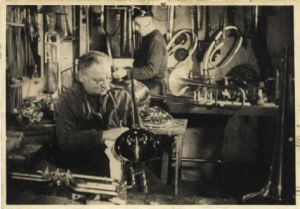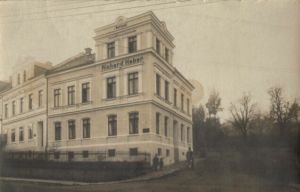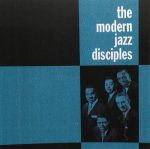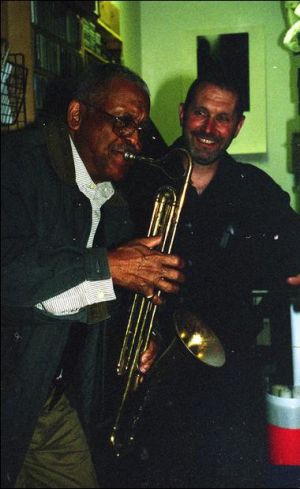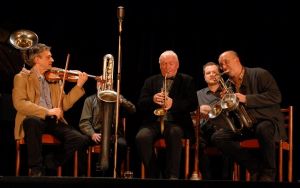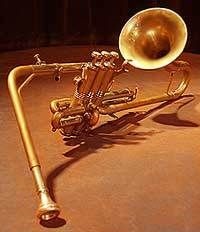Difference between revisions of "Normaphone"
Gwesterhof (talk | contribs) |
Gwesterhof (talk | contribs) |
||
| Line 43: | Line 43: | ||
</gallery> | </gallery> | ||
| + | ==William 'Hicky' Kelley== | ||
William 'Hicky' Kelley played a Normaphone (probably an alto) in 1959 and 1960 with the Modern Jazz Disciples on two records, 'The modern jazz disciples' and 'right down front'. Kelley (March 12, 1929 Cincinnati - May 9, 1998 Cincinnati) started his musical career on the trumpet and later picked up the Normaphone. The notes to the original first album of the Modern Jazz Disciples state that Kelley would like it made clear that that his use of the Normaphon (and the euphonium on one track) is "not one of novelty. He is dedicated to their use as jazz pieces. He has no desire to become an 'avant-courier' for them in the field of jazz." [https://www.youtube.com/watch?v=mAbJ-lKw77U Here]'s Kelley on the Normaphone in Disciples Blues (as of 4.50") (and [http://www.milofultzmusic.com/blog/2015/1/18/lead-sheet-of-disciples-blues here]'s more about this piece). | William 'Hicky' Kelley played a Normaphone (probably an alto) in 1959 and 1960 with the Modern Jazz Disciples on two records, 'The modern jazz disciples' and 'right down front'. Kelley (March 12, 1929 Cincinnati - May 9, 1998 Cincinnati) started his musical career on the trumpet and later picked up the Normaphone. The notes to the original first album of the Modern Jazz Disciples state that Kelley would like it made clear that that his use of the Normaphon (and the euphonium on one track) is "not one of novelty. He is dedicated to their use as jazz pieces. He has no desire to become an 'avant-courier' for them in the field of jazz." [https://www.youtube.com/watch?v=mAbJ-lKw77U Here]'s Kelley on the Normaphone in Disciples Blues (as of 4.50") (and [http://www.milofultzmusic.com/blog/2015/1/18/lead-sheet-of-disciples-blues here]'s more about this piece). | ||
| + | ==Scott Robinson== | ||
Multi instrumentalist Scott Robinson from Teaneck, New Jersey, played a tenor Normaphon on his first LP Multiple Instruments from 1984 and in later years with Hazmat Modine on their CD Bahamut. | Multi instrumentalist Scott Robinson from Teaneck, New Jersey, played a tenor Normaphon on his first LP Multiple Instruments from 1984 and in later years with Hazmat Modine on their CD Bahamut. | ||
And yet another multi instrumentalist, Eric Budd from Melbourne, Australia showing his tenor Normaphon (serial number 0164).</small>]] | And yet another multi instrumentalist, Eric Budd from Melbourne, Australia showing his tenor Normaphon (serial number 0164).</small>]] | ||
| + | ==Tom Guralnick== | ||
Tom Guralnick has a tenor Normaphon (serial number 0238) that he got from Bob Klein in New York around 2001. Bob's father played in the NY Philharmonic and taught in a community music school where he discovered it some 50 years ago when he closed down the music school, and Bob gave it to Tom some 15 years ago. Tom is the director at Outpost, Albuquerque, and occasionally shows the instrument to guest musicians. 'Rosewell Rudd dug it". Here's jazz trumpeter Bobby Bradford (1934) trying, with Tom looking. | Tom Guralnick has a tenor Normaphon (serial number 0238) that he got from Bob Klein in New York around 2001. Bob's father played in the NY Philharmonic and taught in a community music school where he discovered it some 50 years ago when he closed down the music school, and Bob gave it to Tom some 15 years ago. Tom is the director at Outpost, Albuquerque, and occasionally shows the instrument to guest musicians. 'Rosewell Rudd dug it". Here's jazz trumpeter Bobby Bradford (1934) trying, with Tom looking. | ||
| Line 54: | Line 57: | ||
[[File:2013 12 18 Happy New Year Bob Zajicek 1.jpg|thumb|left|<small>Bob Zajíček Kvintet</small>]] [[File:Jazzofon coll Bob Zajicek.jpg|thumb|left|<small>Soprano Normaphon coll. B.Zajíček</small>]] | [[File:2013 12 18 Happy New Year Bob Zajicek 1.jpg|thumb|left|<small>Bob Zajíček Kvintet</small>]] [[File:Jazzofon coll Bob Zajicek.jpg|thumb|left|<small>Soprano Normaphon coll. B.Zajíček</small>]] | ||
| + | ==Bob Zajíček== | ||
Legendary Prague trumpeter and cornettist Luboš 'Bob Zajíček (6-10-1938) and his quintet performed on December 18th, 2013 at ...., with Bob (center) on a soprano Normaphone, ... on Violinophone and .. on a Jazzophone, probably pitched in Eb. Bob Zajíček also hosts a programm called [https://vltava.rozhlas.cz/jazzofon-5057400 JAZZOFON] on radio station Vltava. Zajíček and his friends, playing what's now called traditional jazz, are keeping alive a tradition of which the Jazzophon is the ultimate icon. | Legendary Prague trumpeter and cornettist Luboš 'Bob Zajíček (6-10-1938) and his quintet performed on December 18th, 2013 at ...., with Bob (center) on a soprano Normaphone, ... on Violinophone and .. on a Jazzophone, probably pitched in Eb. Bob Zajíček also hosts a programm called [https://vltava.rozhlas.cz/jazzofon-5057400 JAZZOFON] on radio station Vltava. Zajíček and his friends, playing what's now called traditional jazz, are keeping alive a tradition of which the Jazzophon is the ultimate icon. | ||
| + | =Normaphons overview= | ||
| + | <gallery widths="150" heights="150"> | ||
| + | File:1.jpg|1 | ||
| + | File:2.jpg|2 | ||
| + | File:Normaaa 3.jpg|3 | ||
| + | File:Norma 4.jpg|4 | ||
| + | File:Norma 5.jpg|5 | ||
| + | File:Norma6.jpg|6 | ||
| + | File:0117 jpg.jpg|0117 | ||
| + | File:0315.jpg|0315 | ||
| + | File:0344.jpg|0344 | ||
| + | File:0441.jpg|0441 | ||
| + | File:Nmm 1525. Tenor Normaphon by Heber Workshop, Markneukirchen, Germany, ca. 1930..jpg|1525 | ||
| + | File:NMM 1526 Normaphon 0200 rotary.jpg|200 | ||
| + | File:Normaphon 0109 yogyakarta.jpg|0109 | ||
| + | File:Normaphon 0104.jpg|0104 | ||
| + | File:Normaphon 0187 10,11,12 (1).jpg|0187 | ||
| + | File:Normaphon 0240 (5).jpg|240 | ||
| + | File:Normaphon 0267.jpg|267 | ||
| + | File:Normaphon 0306 tenor (3).jpg|306 | ||
| + | File:Normaphon 362 tenor feb 2018.jpg|362 | ||
| + | File:Normaphon 0390 sopraan 0.jpg|390 | ||
| + | File:Normaphone Tom Guralnick 0238.jpg|238 | ||
| + | File:Normaphons Scott Robinson 1 150.jpg|150 | ||
| + | File:Normaphons Scott Robinson 350 tenor.jpg|350 | ||
| + | </gallery> | ||
| − | + | nr 0104 alto Normaphon D.R.G.M. C.A.Wunderlich Siebenbrunn Vgtl. valve casings stamped 28,29,30 coll. Gerard Westerhof, Netherlands | |
| + | 0109 tenor Normaphon D.R.G.M Trade Mark/Fabrik Marke coll. Gigion Erino @ern_brass Yogyakarta Indonesia | ||
| + | nr 0117 soprano Normaphon D.R.G.M. Germany valve casings and caps stamped 10, 11 and 12. coll. NMM 7350 Joe R. and Joella F. Utley Collection, 1999 Vermillion South Dakota US US | ||
| − | + | nr 150 alto Normaphon, coll. Scott Robinson, Teaneck New Jersey, US | |
| − | + | nr 0164 tenor Normaphon coll. Eric Budd, Melbourne Australia | |
| − | + | nr 0187 tenor Normaphon D.R.G.M. D.R. Patent Germany valve casings stamped 10,11,12, offered on Ebay 2017 | |
| − | + | nr 0196 tenor Normaphon D.R.G.M. C.A.Wunderlich Siebenbrunn Vgtl. coll. Museum für Musikinstrumente der Universität Leipzig | |
| − | + | nr 0200 tenor Normaphon D.R.G.M. Germany rotary valves coll. NMM 1526, Vermillion South Dakota US | |
| + | |||
| + | nr 0238 tenor Normaphon coll. Tom Guralnick Albuquerque US | ||
| + | |||
| + | nr 0240 soprano Normaphon D.R.G.M. D.R. Patent, valve casings stamped 1,2,3, for sale on Ebay.be 2018 | ||
| + | |||
| + | nr 0260 tenor Normaphon D.R.G.M. Germany 8188/M. J. KALASHEN/NEW YORK, valves and valve caps stamped: 16, 17, 18, coll. NMM 1525, Vermillion South Dakota US, acquired in 1977, on display at Meredith Willson Museum, Mason City, Iowa US | ||
| + | |||
| + | nr 0267 tenor Normaphon D.R.G.M. Germany 39819 sold through Ebay 2015 | ||
| + | |||
| + | nr 0306 tenor Normaphon D.R.G.M. C.A.Wunderlich Siebenbrunn Vgtl. sold through Ebay.de 2014 | ||
| + | |||
| + | nr 0315 tenor Normaphon D.R.G.M. coll. Edinburgh University, UK | ||
| + | |||
| + | nr 0344 alto Normaphon, D.R.G.M. acquired in 2010, coll. Han Savelkoel, Netherlands | ||
| + | |||
| + | nr 350 tenor Normaphon, coll. Scott Robinson, Teaneck New Jersey, US | ||
| + | |||
| + | nr 362 tenor Normaphon, D.R.G.M, sold through Auktionshaus Mehlis 2018 | ||
| + | |||
| + | nr 0390 soprano Normaphon D.R.G.M. acquired in 2017 by Dirk Arzig GE | ||
| + | |||
| + | nr 0441 alto Normaphon coll. Heikki Moisio Turku, Finland | ||
| + | |||
| + | 1. tenor Normaphon D.R.G.M. coll. MIM, Phoenix US, (until 2011 Fiske Museum, Claremont, US) (Albert Rice speaks of an alto, D.R.G.M./GERMANY"—sold by C.A. Wunderlich) | ||
| + | |||
| + | 2. tenor Normaphon, D.R.G.M. Germany, restauration with new mouthpipe in 2012 by Robb Stewart, coll. Rick Schwartz, Virginia US | ||
| + | |||
| + | 3. soprano Normaphon D.R.G.M. Germany sold in 1998 through Butterfield & Butterfield (maybe same as 0117) alto | ||
| + | |||
| + | 4. tenor Normaphon, D.R.G.M. C.A.Wunderlich Siebenbrunn, Vgtl, offered from Sintra, Portugal through Olx.pt 2016 | ||
| + | |||
| + | 5 tenor Normaphon C.A.Wunderlich Siebenbrunn, Vgtl, coll. Musik-Museums Basel | ||
| + | |||
| + | 6 bell of a sopran Normaphon D.R.G.M. diameter 11 cm, sold through Ebay.de in 2017 | ||
Revision as of 22:25, 30 May 2019
Contents
The Normaphone
The Normaphon was a saxophone shaped trumpet with only one bell, invented by Richard Oskar Heber (1872-1938) from Markneukirchen. Between 1900 and 1935 he produced brass instruments under the Norma-brand at the Schützenstrasse 36 in Markneukirchen.
Heber advertised the Normaphon as very appropriate for 'Jazz-Band und sonstige Effekt-Kapellen'. Roughly 100 Normaphons were built from approximately 1924/25 until 1930, and were distributed through wholesalers such as C.A. Wunderlich in Siebenbrunn, R.O. Adler, Johannes Adler and C.G Glier in Markneukirchen, Ammon Gläser in Erlbach and M. J. Kalashen in New York. The Gebrüder Schuster in Markneukirchen, 'Fabrik und Export von Musikinstrumenten und Saiten', from 1854, had the Normaphon in their Katalog Nr. 70, (ca. 1929). Normaphons were sent out to musical directors all over the world to promote the new instrument.
The Normaphon also had a D.R.G.M-registration from 26.02.1926, number 51c. 945 751, under the name 'Metallblasinstrument', on Richard Hebers name.
The C.G.Glier catalog from October 1926 states that patents are claimed both at home and abroad. There were four sizes of the instrument (specials possible), but most of them were build in tenor. Albert Rice explains that they were build not only with piston but also with rotary valves. The National Music Museum in Vermillion SD owns the only known rotary valve example. The soprano also had a version with an echo effect-valve, similar to the Jazzophon. Initially, there also was a choice between high and low pitch.
Max Adler from Erlbach offered in his catalogue number 25 also the English high pitch and the Normaphon in C and in F for the same price. Adler advertises the Normaphon as a solo instrument.
Remarkable: C.A. Wunderlich offered around 1928 also a soprano version of the Normaphon with an echo effect valve, a kind of Jazzophon in fact. The New Langwill Index states that C.A. Wunderlich held the Normaphon patent, that could be a misinterpretation or Wunderlich must have acquired it from Heber.
In or after 1931 Robert Oswald Adler still (and only) offered the sopran, alto and tenor Normaphon, as did Johannes Adler in his Liste 31. The 1934 C.A.Wunderlich catalog shows no Normaphons nor Jazzophons anymore.
The National Music Museum of the University of South Dakota has a soprano and two tenor Normaphons, one of them having rotary valves. This last one (serial number 0200), the only example with the usual Normaphon D.R.G.M. Germany engraving with rotary valves known so far, has no distributor name engraved.
Pieter Aafjes, from 1907 - 1947 musical director of Crescendo, a concert band in Culemborg, the Netherlands, obtained an alto Normaphon from C.A. Wunderlich with serial number 0104, to give it a try. Through Riet van Dillen, the daughter of his successor Jac van Dillen, it came in my possession.
Alto Normaphon in Eb, originally nickel plated, serial number 0104. On the bell: C.A. Wunderlich Siebenbrunn Vogtl. coll. Gerard Westerhof
Normaphones can be found amongst others at the Edinburgh University Collection of Historic Musical Instruments, the MIM in Phoenix, the Museum of Musical Instruments of the Leipzig University, the HJM Brass Collection in Turku, Finland and the Trompetenmuseum in Bad Säckingen (that has a tenor from Schuster & Co.).
In 1956 Karl Linsenmeijer, then 16 years old, entered the Musikverein Offnadingen (a small village near Freiburg, Germany) and played an alto Normaphon untill he changed to clarinet in 1965. He played it together with Karl Schleer, who changed to flugelhorn. The Musikverein had severe losses during WWII, having only 5 active members left in 1945. The Normaphon was bought because at the time the money was very tight and sometimes even two musicians had only one instrument, so Jürgen Schleer, now chairman and son of Karl. Where it was bought is not known, after 1965 it went to a music store. In the orchestra the Normaphon was counted as a flugelhorn, the notes were always rewritten by the conductor, mostly from the tenor horn. "The exotic Normaphon has always been a highlight and an eye-catcher at every party and every performance', says Jürgen.
In 1957 Nat King Cole performed 'Rosetta' in one of his shows together with Billy Eckstine (8 July 1914 – 8 March 1993), Eckstine playing a tenor Normaphone (from 2.12").
William 'Hicky' Kelley
William 'Hicky' Kelley played a Normaphone (probably an alto) in 1959 and 1960 with the Modern Jazz Disciples on two records, 'The modern jazz disciples' and 'right down front'. Kelley (March 12, 1929 Cincinnati - May 9, 1998 Cincinnati) started his musical career on the trumpet and later picked up the Normaphone. The notes to the original first album of the Modern Jazz Disciples state that Kelley would like it made clear that that his use of the Normaphon (and the euphonium on one track) is "not one of novelty. He is dedicated to their use as jazz pieces. He has no desire to become an 'avant-courier' for them in the field of jazz." Here's Kelley on the Normaphone in Disciples Blues (as of 4.50") (and here's more about this piece).
Scott Robinson
Multi instrumentalist Scott Robinson from Teaneck, New Jersey, played a tenor Normaphon on his first LP Multiple Instruments from 1984 and in later years with Hazmat Modine on their CD Bahamut. And yet another multi instrumentalist, Eric Budd from Melbourne, Australia showing his tenor Normaphon (serial number 0164).]]
Tom Guralnick
Tom Guralnick has a tenor Normaphon (serial number 0238) that he got from Bob Klein in New York around 2001. Bob's father played in the NY Philharmonic and taught in a community music school where he discovered it some 50 years ago when he closed down the music school, and Bob gave it to Tom some 15 years ago. Tom is the director at Outpost, Albuquerque, and occasionally shows the instrument to guest musicians. 'Rosewell Rudd dug it". Here's jazz trumpeter Bobby Bradford (1934) trying, with Tom looking.
Bob Zajíček
Legendary Prague trumpeter and cornettist Luboš 'Bob Zajíček (6-10-1938) and his quintet performed on December 18th, 2013 at ...., with Bob (center) on a soprano Normaphone, ... on Violinophone and .. on a Jazzophone, probably pitched in Eb. Bob Zajíček also hosts a programm called JAZZOFON on radio station Vltava. Zajíček and his friends, playing what's now called traditional jazz, are keeping alive a tradition of which the Jazzophon is the ultimate icon.
Normaphons overview
- Norma 5.jpg
5
nr 0104 alto Normaphon D.R.G.M. C.A.Wunderlich Siebenbrunn Vgtl. valve casings stamped 28,29,30 coll. Gerard Westerhof, Netherlands
0109 tenor Normaphon D.R.G.M Trade Mark/Fabrik Marke coll. Gigion Erino @ern_brass Yogyakarta Indonesia
nr 0117 soprano Normaphon D.R.G.M. Germany valve casings and caps stamped 10, 11 and 12. coll. NMM 7350 Joe R. and Joella F. Utley Collection, 1999 Vermillion South Dakota US US
nr 150 alto Normaphon, coll. Scott Robinson, Teaneck New Jersey, US
nr 0164 tenor Normaphon coll. Eric Budd, Melbourne Australia
nr 0187 tenor Normaphon D.R.G.M. D.R. Patent Germany valve casings stamped 10,11,12, offered on Ebay 2017
nr 0196 tenor Normaphon D.R.G.M. C.A.Wunderlich Siebenbrunn Vgtl. coll. Museum für Musikinstrumente der Universität Leipzig
nr 0200 tenor Normaphon D.R.G.M. Germany rotary valves coll. NMM 1526, Vermillion South Dakota US
nr 0238 tenor Normaphon coll. Tom Guralnick Albuquerque US
nr 0240 soprano Normaphon D.R.G.M. D.R. Patent, valve casings stamped 1,2,3, for sale on Ebay.be 2018
nr 0260 tenor Normaphon D.R.G.M. Germany 8188/M. J. KALASHEN/NEW YORK, valves and valve caps stamped: 16, 17, 18, coll. NMM 1525, Vermillion South Dakota US, acquired in 1977, on display at Meredith Willson Museum, Mason City, Iowa US
nr 0267 tenor Normaphon D.R.G.M. Germany 39819 sold through Ebay 2015
nr 0306 tenor Normaphon D.R.G.M. C.A.Wunderlich Siebenbrunn Vgtl. sold through Ebay.de 2014
nr 0315 tenor Normaphon D.R.G.M. coll. Edinburgh University, UK
nr 0344 alto Normaphon, D.R.G.M. acquired in 2010, coll. Han Savelkoel, Netherlands
nr 350 tenor Normaphon, coll. Scott Robinson, Teaneck New Jersey, US
nr 362 tenor Normaphon, D.R.G.M, sold through Auktionshaus Mehlis 2018
nr 0390 soprano Normaphon D.R.G.M. acquired in 2017 by Dirk Arzig GE
nr 0441 alto Normaphon coll. Heikki Moisio Turku, Finland
1. tenor Normaphon D.R.G.M. coll. MIM, Phoenix US, (until 2011 Fiske Museum, Claremont, US) (Albert Rice speaks of an alto, D.R.G.M./GERMANY"—sold by C.A. Wunderlich)
2. tenor Normaphon, D.R.G.M. Germany, restauration with new mouthpipe in 2012 by Robb Stewart, coll. Rick Schwartz, Virginia US
3. soprano Normaphon D.R.G.M. Germany sold in 1998 through Butterfield & Butterfield (maybe same as 0117) alto
4. tenor Normaphon, D.R.G.M. C.A.Wunderlich Siebenbrunn, Vgtl, offered from Sintra, Portugal through Olx.pt 2016
5 tenor Normaphon C.A.Wunderlich Siebenbrunn, Vgtl, coll. Musik-Museums Basel
6 bell of a sopran Normaphon D.R.G.M. diameter 11 cm, sold through Ebay.de in 2017
